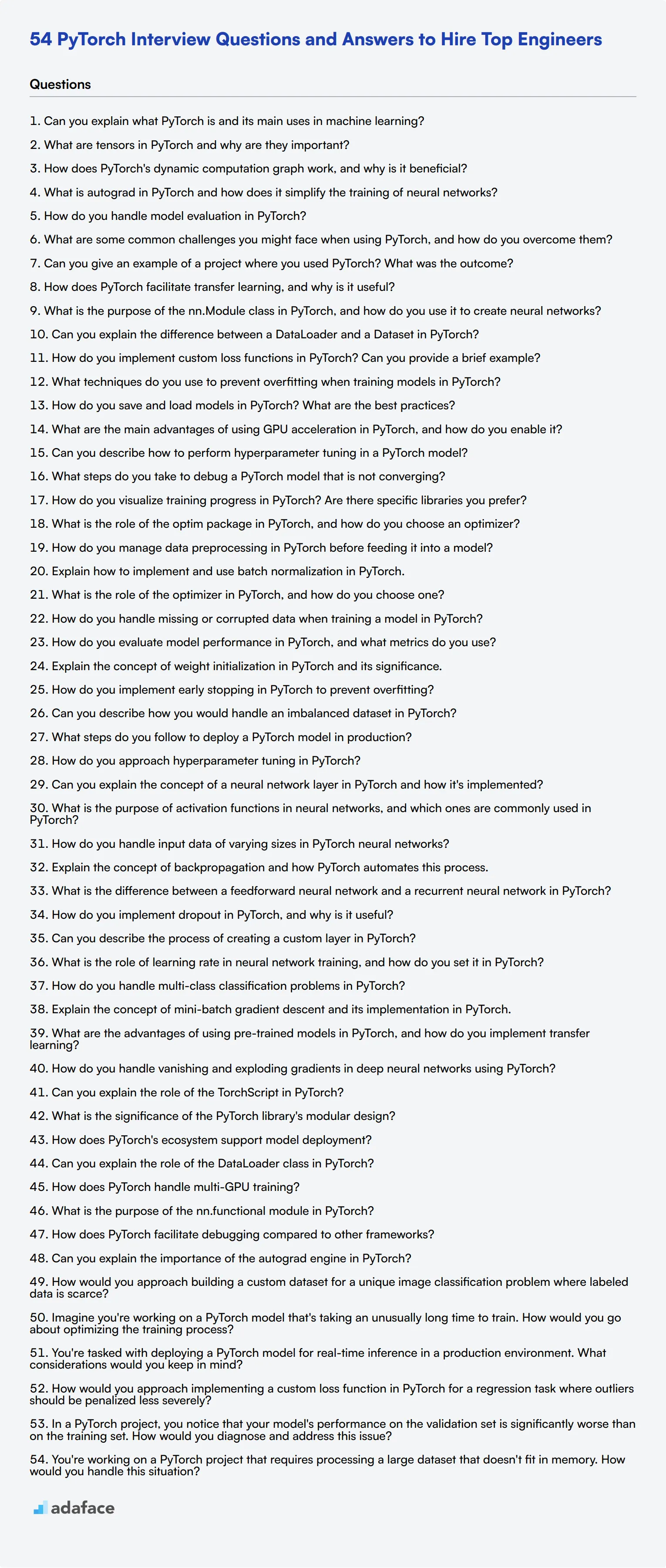Hiring the right PyTorch talent is crucial for companies building advanced machine learning and deep learning solutions. Asking the right interview questions helps you assess candidates' knowledge, problem-solving skills, and practical experience with this powerful deep learning framework.
This blog post provides a comprehensive list of PyTorch interview questions tailored for different experience levels, from junior to senior engineers. We cover general PyTorch concepts, neural network basics, framework architecture, and situational questions to help you evaluate candidates thoroughly.
By using these questions, you can identify top PyTorch talent and make informed hiring decisions. Consider pairing these interview questions with a pre-employment PyTorch assessment to get a complete picture of candidates' skills before the interview stage.
Table of contents
8 general PyTorch interview questions and answers to assess applicants
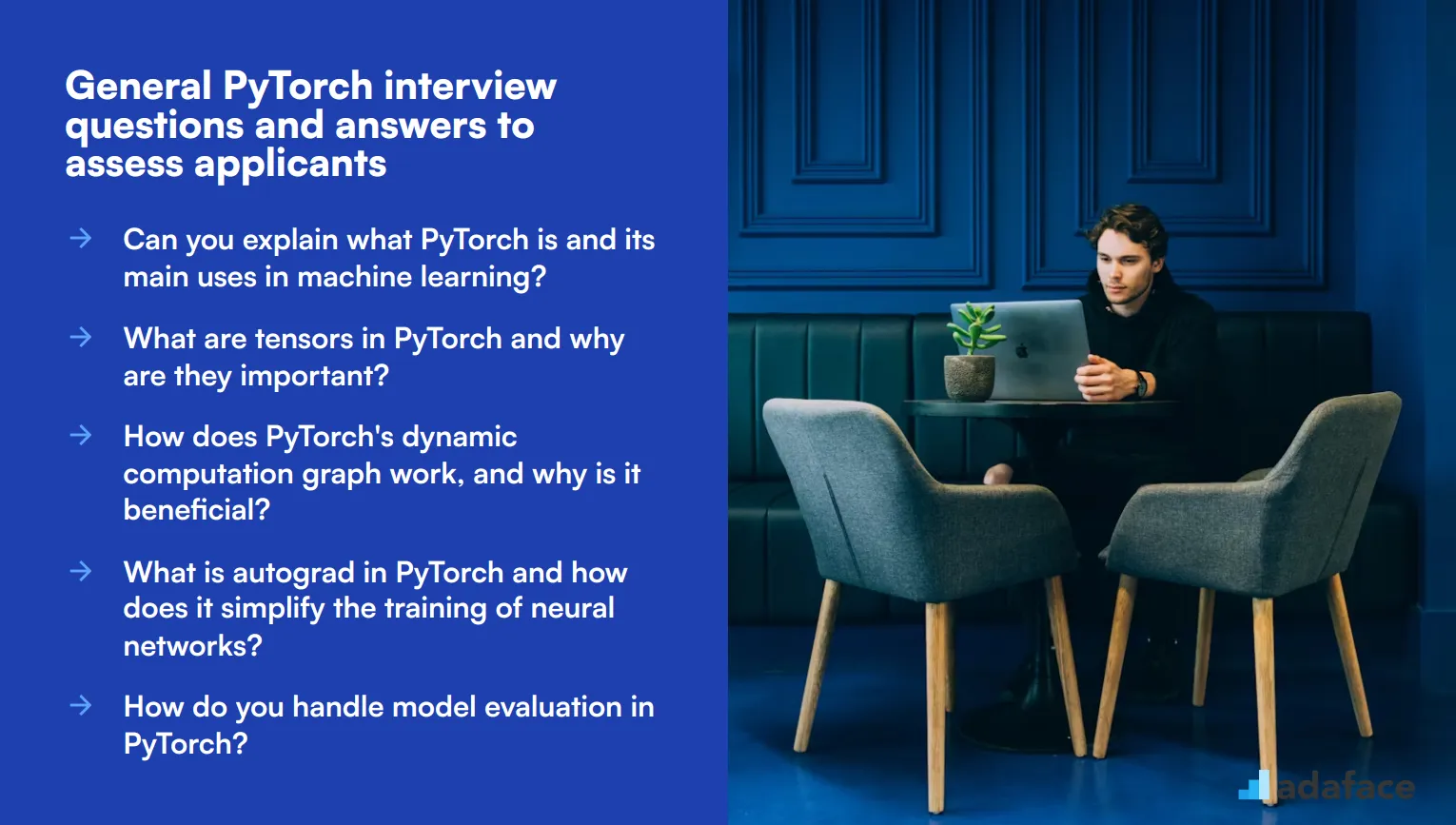
To determine if your candidates have a solid grasp of PyTorch, ask them some of these general interview questions. These questions are designed to gauge their understanding and practical knowledge of the framework. Ideal for interviews, these questions help you identify applicants who can effectively work with PyTorch in real-world scenarios.
1. Can you explain what PyTorch is and its main uses in machine learning?
PyTorch is an open-source machine learning library developed by Facebook's AI Research lab. It is widely used for applications such as natural language processing and computer vision. PyTorch offers dynamic computational graphs, which allow you to modify the graph on the go, making it very flexible and user-friendly.
An ideal candidate should demonstrate awareness of PyTorch's popularity in research and industry. They should mention its ease of use, extensive community support, and robust ecosystem which includes tools like Torchvision for computer vision tasks. Watch for candidates who can articulate why PyTorch might be chosen over other frameworks like TensorFlow.
2. What are tensors in PyTorch and why are they important?
Tensors are the primary data structures in PyTorch. They are multi-dimensional arrays similar to NumPy arrays but with additional capabilities for GPU acceleration. Tensors enable efficient computation and are essential for defining and training neural networks.
Look for candidates who can explain how tensors facilitate the handling of large datasets and complex mathematical operations required for machine learning. They should mention that tensors can be easily transferred between CPUs and GPUs, highlighting PyTorch's strength in computational efficiency.
3. How does PyTorch's dynamic computation graph work, and why is it beneficial?
PyTorch's dynamic computation graph, also known as define-by-run, allows the graph to be built on-the-fly as operations are executed. This means the graph is created during runtime, making it much easier to debug and modify compared to static computation graphs.
Candidates should mention the flexibility and ease of debugging that dynamic graphs provide. They might also compare it with static graphs used in frameworks like TensorFlow, emphasizing how PyTorch's approach can simplify the development of complex models. An ideal response would also highlight the advantage in research settings where models often need frequent modifications.
4. What is autograd in PyTorch and how does it simplify the training of neural networks?
Autograd in PyTorch is an automatic differentiation library that records operations performed on tensors to create a computation graph. During the backward pass, autograd computes gradients automatically, simplifying the process of training neural networks.
Candidates should articulate how autograd eliminates the need for manually computing gradients, thus reducing the complexity of model training. Look for responses that highlight how autograd's ease of use and efficiency make it a powerful tool for both beginners and experts in machine learning.
5. How do you handle model evaluation in PyTorch?
Model evaluation in PyTorch typically involves splitting the dataset into training, validation, and test sets. The model is trained on the training set, hyperparameters are tuned using the validation set, and the final evaluation is performed on the test set. Metrics such as accuracy, precision, recall, and F1 score can be used to quantify performance.
An ideal candidate should mention the importance of preventing overfitting by using a separate validation set. They should also discuss the use of various evaluation metrics depending on the specific problem, such as classification or regression. Look for responses that reflect a thorough understanding of the evaluation process and the ability to interpret different metrics.
6. What are some common challenges you might face when using PyTorch, and how do you overcome them?
Common challenges with PyTorch include dealing with complex data preprocessing, managing GPU memory efficiently, and debugging dynamic graphs. Overcoming these challenges often involves using PyTorch's extensive libraries and tools, following best practices for memory management, and leveraging the vibrant community for support.
A strong candidate should be able to discuss specific strategies they have used to address these issues. For example, they might mention using DataLoader for efficient data loading or employing techniques to optimize GPU memory usage. They should also emphasize the importance of staying updated with PyTorch's ongoing developments and improvements.
7. Can you give an example of a project where you used PyTorch? What was the outcome?
Candidates should describe a specific project where they used PyTorch, detailing the problem they aimed to solve, the model they built, and the results they achieved. This could range from personal projects to academic research or professional applications.
Look for candidates who can clearly articulate the problem-solving process and the impact of their work. They should mention any challenges faced and how they overcame them, as well as any significant outcomes or learnings from the project. This question helps assess practical experience and the ability to apply PyTorch effectively in real-world scenarios.
8. How does PyTorch facilitate transfer learning, and why is it useful?
Transfer learning in PyTorch is facilitated through pre-trained models available in libraries like Torchvision. Transfer learning allows you to leverage pre-trained models on large datasets and fine-tune them for specific tasks, significantly reducing training time and improving performance.
Candidates should explain the concept of transfer learning and its benefits, such as faster convergence and reduced computational resources. They should mention practical applications, like using pre-trained models for image classification or natural language processing tasks. An ideal response would include a discussion on how transfer learning can be a game-changer in scenarios with limited data.
10 PyTorch interview questions to ask junior engineers
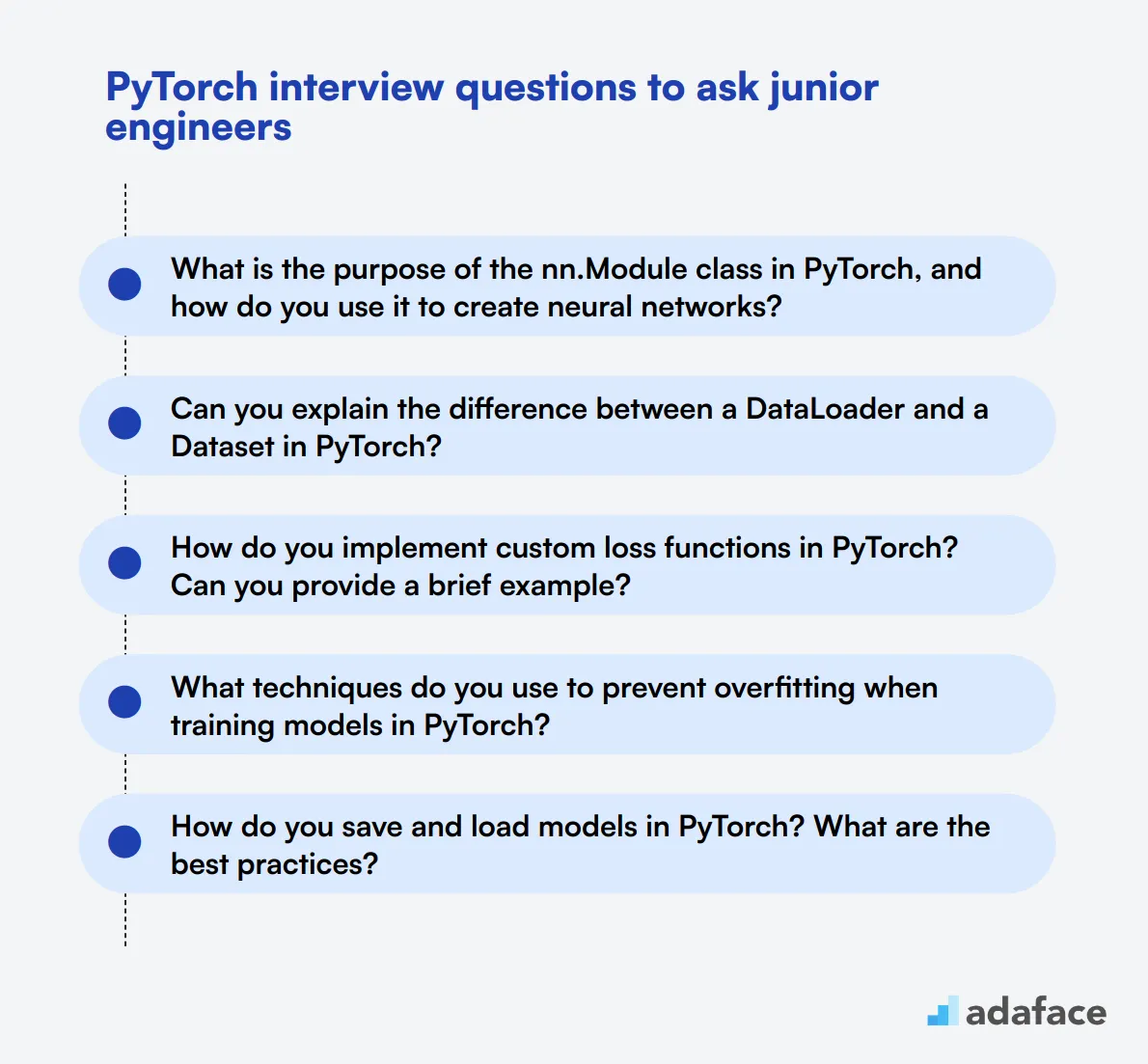
To ensure that your candidates possess the essential skills in using PyTorch effectively, consider utilizing this list of targeted interview questions. These questions will help you gauge their understanding and practical experience in key areas relevant to roles such as a machine learning engineer.
- What is the purpose of the nn.Module class in PyTorch, and how do you use it to create neural networks?
- Can you explain the difference between a DataLoader and a Dataset in PyTorch?
- How do you implement custom loss functions in PyTorch? Can you provide a brief example?
- What techniques do you use to prevent overfitting when training models in PyTorch?
- How do you save and load models in PyTorch? What are the best practices?
- What are the main advantages of using GPU acceleration in PyTorch, and how do you enable it?
- Can you describe how to perform hyperparameter tuning in a PyTorch model?
- What steps do you take to debug a PyTorch model that is not converging?
- How do you visualize training progress in PyTorch? Are there specific libraries you prefer?
- What is the role of the optim package in PyTorch, and how do you choose an optimizer?
10 intermediate PyTorch interview questions and answers to ask mid-tier engineers
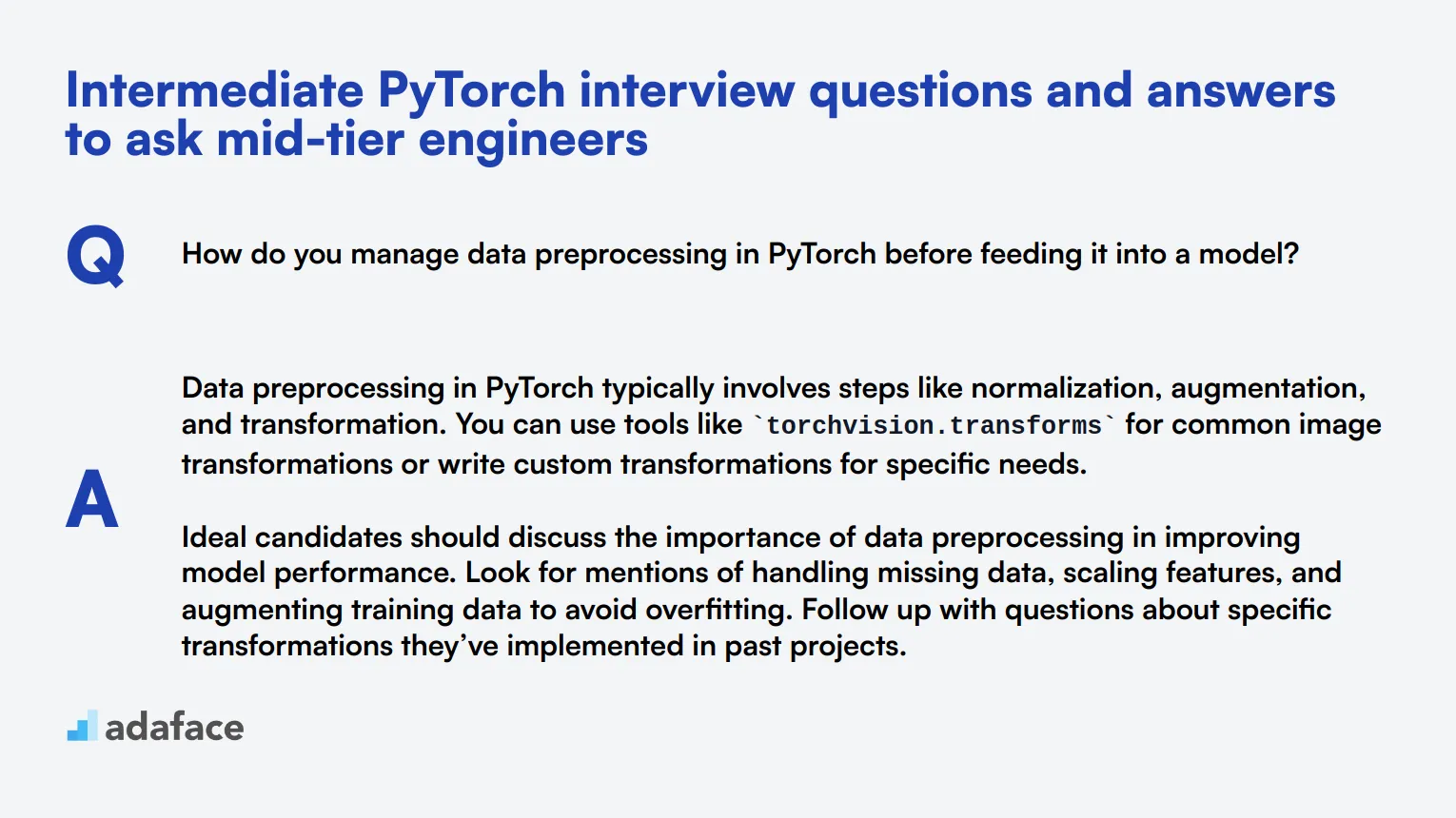
To determine whether your applicants have the right intermediate skills to work with PyTorch, ask them some of these 10 PyTorch interview questions about processes and practical applications.
1. How do you manage data preprocessing in PyTorch before feeding it into a model?
Data preprocessing in PyTorch typically involves steps like normalization, augmentation, and transformation. You can use tools like torchvision.transforms for common image transformations or write custom transformations for specific needs.
Ideal candidates should discuss the importance of data preprocessing in improving model performance. Look for mentions of handling missing data, scaling features, and augmenting training data to avoid overfitting. Follow up with questions about specific transformations they’ve implemented in past projects.
2. Explain how to implement and use batch normalization in PyTorch.
Batch normalization is implemented using torch.nn.BatchNorm2d for 2D data like images. It normalizes the inputs for each mini-batch, which helps in stabilizing the learning process and speeding up the training.
Candidates should highlight the benefits of batch normalization, such as reducing internal covariate shift and allowing higher learning rates. They should also explain how it can be applied in different parts of the neural network architecture. Look for their understanding of the parameters involved, like momentum and epsilon.
3. What is the role of the optimizer in PyTorch, and how do you choose one?
The optimizer in PyTorch is used to update the model parameters based on the computed gradients. Popular optimizers include SGD, Adam, and RMSprop, each with its own advantages.
Candidates should demonstrate a clear understanding of how different optimizers work and the criteria for choosing one, such as learning rate, convergence speed, and computational efficiency. Look for their experience in tuning optimizer hyperparameters and dealing with issues like vanishing gradients.
4. How do you handle missing or corrupted data when training a model in PyTorch?
Handling missing data typically involves strategies like imputation, deletion, or using algorithms that support missing values. In PyTorch, data augmentation techniques can also be used to mitigate the impact of missing data.
Strong candidates will discuss various techniques and their pros and cons, such as mean/median imputation or using models like Random Forest that handle missing values. They should also mention the importance of understanding the underlying data distribution before choosing a method. Follow up on how they've applied these techniques in past projects.
5. How do you evaluate model performance in PyTorch, and what metrics do you use?
Model performance in PyTorch can be evaluated using metrics like accuracy, precision, recall, and F1 score. torchmetrics library can be used to simplify this process.
Candidates should show familiarity with different evaluation metrics and their relevance to the specific problem at hand. They should also discuss the importance of splitting data into training and validation sets to avoid overfitting. Look for their experience in using confusion matrices, ROC curves, and other evaluation tools.
6. Explain the concept of weight initialization in PyTorch and its significance.
Weight initialization is the process of setting the initial values of weights in a neural network before training begins. Proper initialization can help in faster convergence and avoid issues like vanishing or exploding gradients.
Candidates should be able to discuss different initialization techniques, such as Xavier and He initialization, and their suitability for various activation functions. Look for their understanding of the impact of weight initialization on the training process and any real-world examples they can provide.
7. How do you implement early stopping in PyTorch to prevent overfitting?
Early stopping is a technique used to halt training when the validation performance starts to deteriorate, indicating overfitting. This can be implemented in PyTorch by monitoring the validation loss during training and stopping when certain criteria are met.
Candidates should discuss the importance of early stopping for model generalization and the specific criteria they use for stopping, such as patience and minimum delta. They should also mention any experience with libraries that facilitate early stopping. Look for their understanding of balancing training duration and model performance.
8. Can you describe how you would handle an imbalanced dataset in PyTorch?
Handling imbalanced datasets can involve techniques like resampling (oversampling minority class or undersampling majority class), using different loss functions, or applying data augmentation.
Candidates should discuss the pros and cons of each approach and their experiences in dealing with imbalanced data. Look for their knowledge of tools like torch.utils.data.WeightedRandomSampler and their understanding of how imbalanced data affects model performance metrics.
9. What steps do you follow to deploy a PyTorch model in production?
Deploying a PyTorch model involves steps like model serialization using torch.save and torch.load, converting the model into a format suitable for inference (like TorchScript), and setting up an inference server using frameworks like Flask or FastAPI.
Candidates should detail their experience with different deployment strategies and tools. Look for their understanding of scalability, latency, and monitoring aspects. Ask for specific examples of how they’ve handled deployment challenges in the past.
10. How do you approach hyperparameter tuning in PyTorch?
Hyperparameter tuning can be done using techniques like grid search, random search, or more sophisticated approaches like Bayesian optimization. Libraries like Optuna can be used to facilitate this process.
Candidates should discuss the importance of hyperparameter tuning for model performance and their experience with different techniques. Look for their ability to balance exploration and exploitation, and their understanding of how hyperparameters influence model training. They should also mention any tools or libraries they prefer for hyperparameter tuning.
12 PyTorch questions related to neural network basics
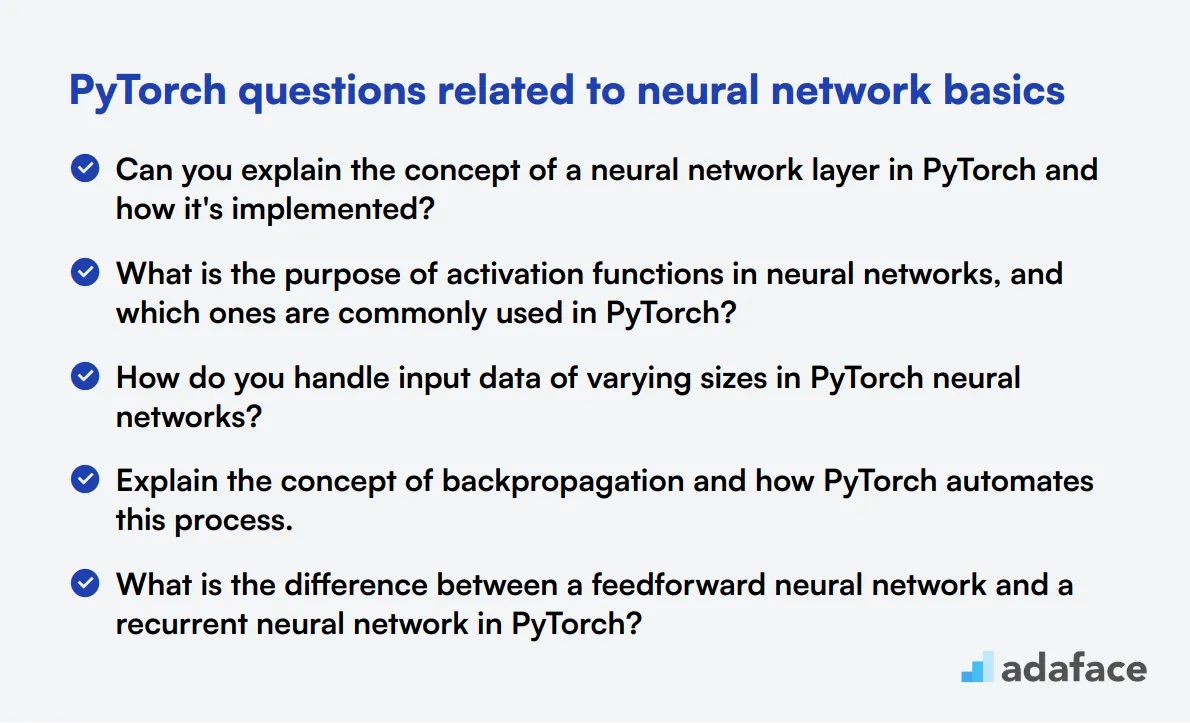
To assess a candidate's understanding of neural network fundamentals in PyTorch, consider using these 12 interview questions. They are designed to help hiring managers and recruiters evaluate an applicant's grasp of essential concepts crucial for machine learning roles. These questions cover key aspects of neural network architecture and implementation in PyTorch.
- Can you explain the concept of a neural network layer in PyTorch and how it's implemented?
- What is the purpose of activation functions in neural networks, and which ones are commonly used in PyTorch?
- How do you handle input data of varying sizes in PyTorch neural networks?
- Explain the concept of backpropagation and how PyTorch automates this process.
- What is the difference between a feedforward neural network and a recurrent neural network in PyTorch?
- How do you implement dropout in PyTorch, and why is it useful?
- Can you describe the process of creating a custom layer in PyTorch?
- What is the role of learning rate in neural network training, and how do you set it in PyTorch?
- How do you handle multi-class classification problems in PyTorch?
- Explain the concept of mini-batch gradient descent and its implementation in PyTorch.
- What are the advantages of using pre-trained models in PyTorch, and how do you implement transfer learning?
- How do you handle vanishing and exploding gradients in deep neural networks using PyTorch?
8 PyTorch interview questions and answers related to framework architecture
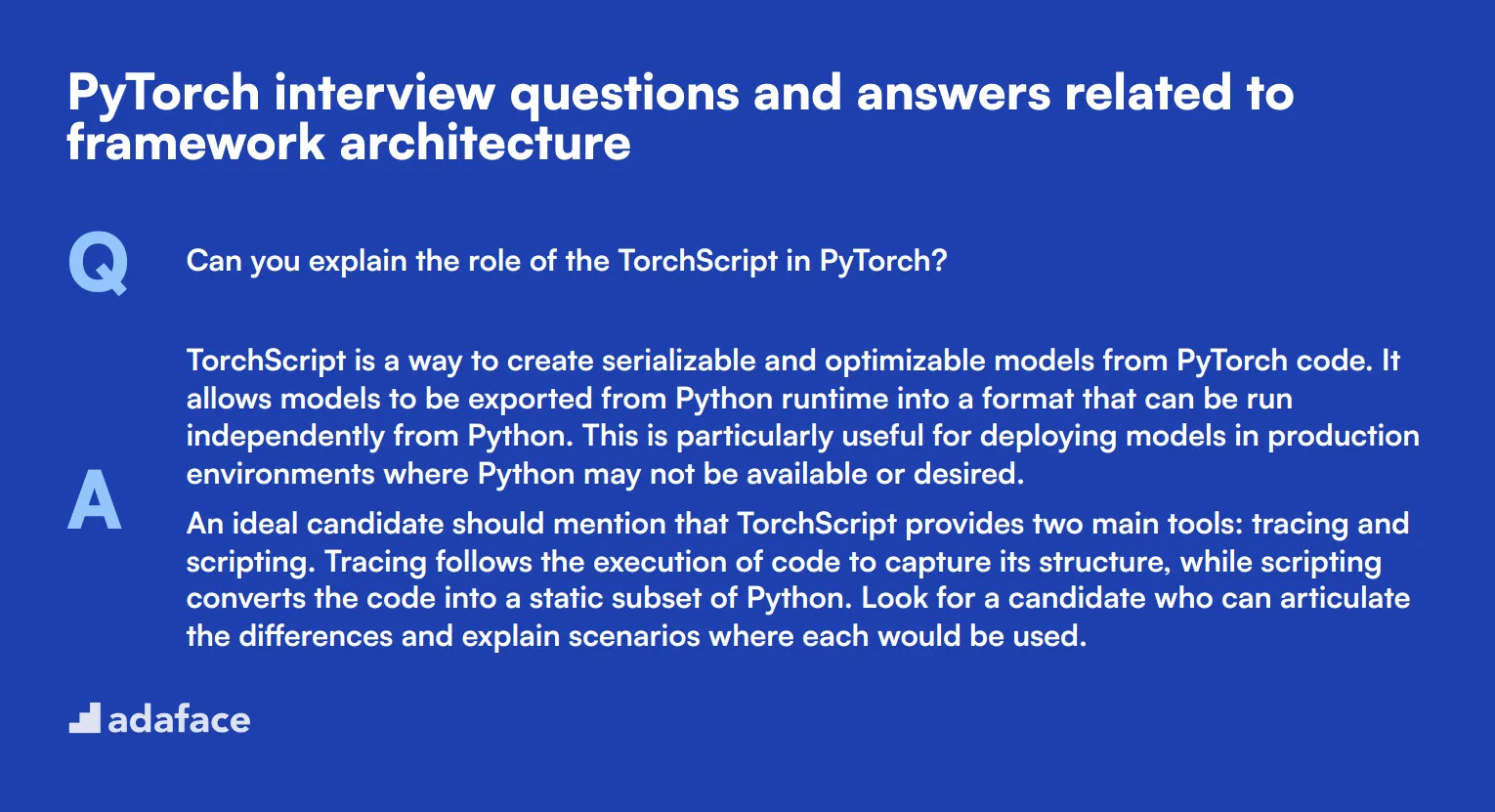
To assess whether your candidates have a solid grasp of PyTorch's architecture and how it fits into the broader landscape of machine learning, use these carefully curated interview questions. This list will help you gauge not just technical knowledge but also practical understanding, ensuring you identify the best fit for your team.
1. Can you explain the role of the TorchScript in PyTorch?
TorchScript is a way to create serializable and optimizable models from PyTorch code. It allows models to be exported from Python runtime into a format that can be run independently from Python. This is particularly useful for deploying models in production environments where Python may not be available or desired.
An ideal candidate should mention that TorchScript provides two main tools: tracing and scripting. Tracing follows the execution of code to capture its structure, while scripting converts the code into a static subset of Python. Look for a candidate who can articulate the differences and explain scenarios where each would be used.
2. What is the significance of the PyTorch library's modular design?
PyTorch's modular design means that it is built with a flexible and modular approach, allowing users to pick and choose components as needed. This makes it highly adaptable to various use cases, whether it's for research-oriented tasks or production-grade applications.
Candidates should highlight that this design enables easier debugging, testing, and integration with other libraries and frameworks. Strong answers will emphasize how this modularity aids in rapid experimentation and prototyping, key aspects for iterative development in machine learning projects.
3. How does PyTorch's ecosystem support model deployment?
PyTorch offers several tools and libraries that facilitate model deployment. For example, TorchServe is a flexible and easy-to-use tool for serving PyTorch models in production. It supports multi-model serving, logging, metrics, and more.
Candidates should also mention integrations with other platforms like ONNX (Open Neural Network Exchange) for interoperability and the ability to run models on different hardware environments. Look for candidates who can discuss specific deployment scenarios and how PyTorch's ecosystem meets those needs.
4. Can you explain the role of the DataLoader class in PyTorch?
The DataLoader class in PyTorch is essential for loading data in a way that's efficient and convenient. It provides functionalities like batching, shuffling, and parallel data loading, which are crucial for training large-scale models efficiently.
Candidates should explain that DataLoader works hand-in-hand with Dataset classes to ensure data is fed into the model in a streamlined manner. An ideal answer would include examples of how using DataLoader optimizes the training process, especially when dealing with large datasets.
5. How does PyTorch handle multi-GPU training?
PyTorch provides multiple ways to perform multi-GPU training, such as DataParallel and DistributedDataParallel. DataParallel is the simpler of the two and allows for easy parallelization over multiple GPUs by splitting the input data and performing computations across GPUs in parallel.
Candidates should be able to explain that DistributedDataParallel offers better performance and scalability by reducing the overhead associated with model synchronization. Look for a candidate who can discuss the pros and cons of each method and when to use them.
For more insights on this topic, you can refer to this PyTorch interview guide.
6. What is the purpose of the nn.functional module in PyTorch?
The nn.functional module in PyTorch provides a variety of functions that are used to construct neural network layers. This includes operations like convolutions, activations, and loss functions, among others.
Candidates should mention that while nn.functional provides stateless functions, the nn.Module counterparts are stateful and maintain learnable parameters. This distinction is crucial for understanding when to use each. Look for candidates who can illustrate this with examples and discuss scenarios where one might be preferred over the other.
7. How does PyTorch facilitate debugging compared to other frameworks?
PyTorch's dynamic computation graph, also known as define-by-run, makes debugging much more intuitive compared to static graph frameworks. This allows you to use standard Python debugging tools, such as pdb or PyCharm's debugger, directly within your model code.
Candidates should be able to discuss how this feature simplifies the process of diagnosing issues and iterating on model architecture compared to other frameworks that use static computation graphs. Strong candidates will also mention the ease of adding print statements or using Python's interactive capabilities to inspect intermediate outputs.
8. Can you explain the importance of the autograd engine in PyTorch?
The autograd engine in PyTorch is a powerful feature that automatically computes the gradients needed for backpropagation. This is crucial for training neural networks, as it simplifies the process by eliminating the need for manual gradient calculations.
Candidates should highlight that autograd works by recording operations performed on tensors, enabling automatic differentiation. An ideal response will include a discussion on how this feature accelerates model development and debugging. Look for candidates who can clearly articulate the benefits of this automatic differentiation and how it streamlines the training process.
6 situational PyTorch interview questions with answers for hiring top engineers
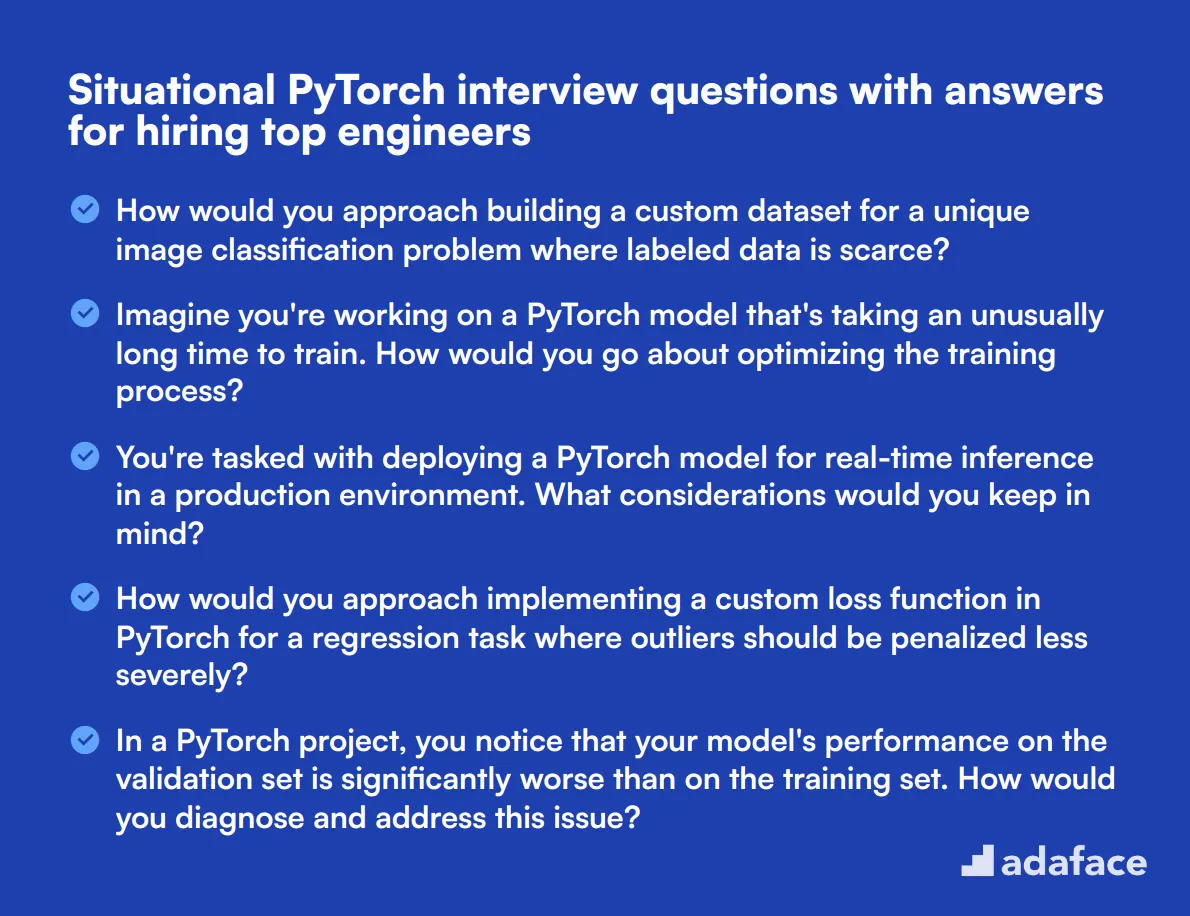
Ready to dive into the deep end of PyTorch interviews? These situational questions will help you assess candidates' real-world problem-solving skills and PyTorch expertise. Use them to gauge how well potential hires can apply their knowledge to practical scenarios. Remember, the best engineers don't just recite facts—they creatively tackle challenges!
1. How would you approach building a custom dataset for a unique image classification problem where labeled data is scarce?
A strong candidate should discuss several approaches to tackle this challenge:
- Data augmentation: Applying transformations like rotations, flips, and color jittering to existing images to artificially expand the dataset.
- Transfer learning: Utilizing pre-trained models on larger datasets and fine-tuning them for the specific problem.
- Semi-supervised learning: Leveraging a small amount of labeled data along with a larger pool of unlabeled data.
- Synthetic data generation: Creating artificial images that mimic the characteristics of the target dataset.
- Active learning: Iteratively selecting the most informative samples for labeling to maximize the value of limited labeling resources.
Look for candidates who demonstrate a creative approach to data scarcity and understand the trade-offs between different methods. Follow up by asking about their experience with any of these techniques in real-world projects.
2. Imagine you're working on a PyTorch model that's taking an unusually long time to train. How would you go about optimizing the training process?
An ideal response should cover multiple aspects of optimization:
- Profiling: Using PyTorch's built-in profiler to identify bottlenecks in the code.
- Data loading: Optimizing the DataLoader by increasing num_workers, using pin_memory=True for GPU training, and considering dataset caching.
- Model architecture: Simplifying the model if possible, or using more efficient architectures.
- Batch size: Experimenting with larger batch sizes (if memory allows) to leverage GPU parallelism.
- Mixed precision training: Utilizing float16 along with float32 to speed up computations on compatible GPUs.
- Gradient accumulation: For handling larger effective batch sizes with limited memory.
- Distributed training: Leveraging multiple GPUs or machines if available.
A strong candidate should not only list these options but also explain how they would systematically apply and test each optimization. Look for answers that demonstrate a methodical approach to problem-solving and a deep understanding of PyTorch's capabilities.
3. You're tasked with deploying a PyTorch model for real-time inference in a production environment. What considerations would you keep in mind?
A comprehensive answer should address several key aspects of model deployment:
- Model optimization: Converting the model to TorchScript for better performance and portability.
- Hardware selection: Choosing appropriate hardware (CPU, GPU, or specialized accelerators) based on latency and throughput requirements.
- Serving framework: Selecting a suitable serving framework like TorchServe or ONNX Runtime.
- Scalability: Implementing load balancing and auto-scaling to handle varying traffic.
- Monitoring: Setting up logging and monitoring for model performance and system health.
- Versioning: Implementing a system for model versioning and easy rollbacks.
- Input/Output processing: Ensuring efficient pre-processing and post-processing pipelines.
- Security: Implementing measures to protect the model and data.
Look for candidates who demonstrate a holistic understanding of the deployment process, balancing performance, reliability, and maintainability. A strong answer might also mention experience with cloud platforms or containerization technologies for deployment.
4. How would you approach implementing a custom loss function in PyTorch for a regression task where outliers should be penalized less severely?
A strong answer should outline the following steps:
- Subclass nn.Module: Create a custom loss function by subclassing nn.Module.
- Implement the forward method: Define the computation of the loss in the forward method.
- Choose an appropriate function: Select a function that grows more slowly for large errors, such as Huber loss or log-cosh loss.
- Parameterization: Include parameters that control the point at which the loss transitions from quadratic to linear behavior.
- Testing: Implement unit tests to verify the loss function behaves as expected for various inputs.
Look for candidates who can explain the mathematical intuition behind their chosen loss function and how it addresses the outlier problem. A particularly strong response might discuss the trade-offs between different robust loss functions and how to tune their parameters during training.
5. In a PyTorch project, you notice that your model's performance on the validation set is significantly worse than on the training set. How would you diagnose and address this issue?
A comprehensive answer should cover the following points:
- Identify overfitting: Recognize that the performance discrepancy likely indicates overfitting.
- Analyze learning curves: Plot training and validation loss over epochs to visualize the divergence point.
- Data augmentation: Implement or increase data augmentation to improve generalization.
- Regularization: Add or increase regularization techniques like L1/L2 regularization or dropout.
- Simplify model: Consider reducing model complexity if it's too powerful for the dataset.
- Early stopping: Implement early stopping to prevent overfitting during training.
- Cross-validation: Use k-fold cross-validation to ensure the issue isn't due to an unrepresentative validation set.
- Ensemble methods: Consider ensemble techniques to improve generalization.
Look for candidates who demonstrate a systematic approach to problem-solving and a deep understanding of machine learning principles. A strong answer might also include discussion of how to implement these solutions specifically in PyTorch.
6. You're working on a PyTorch project that requires processing a large dataset that doesn't fit in memory. How would you handle this situation?
An effective answer should cover several strategies:
- Custom Dataset: Implement a custom Dataset class that loads data on-the-fly from disk or a database.
- Data streaming: Use data streaming techniques to process data in chunks.
- Memory-mapped files: Utilize memory-mapped files for efficient access to large datasets.
- Distributed data loading: Implement distributed data loading using DistributedSampler.
- Data preprocessing: Preprocess and save data in an efficient format like HDF5 or TFRecord.
- Caching: Implement intelligent caching mechanisms for frequently accessed data.
- Out-of-core learning: Consider using out-of-core learning algorithms if applicable.
Look for candidates who can explain the trade-offs between these approaches and demonstrate knowledge of PyTorch's data handling capabilities. A strong answer might also include experience with specific libraries or tools for handling large datasets in PyTorch projects.
Which PyTorch skills should you evaluate during the interview phase?
While it's impossible to assess every aspect of a candidate's PyTorch expertise in a single interview, focusing on core skills can provide valuable insights. The following key areas are particularly important when evaluating PyTorch proficiency during the interview process.
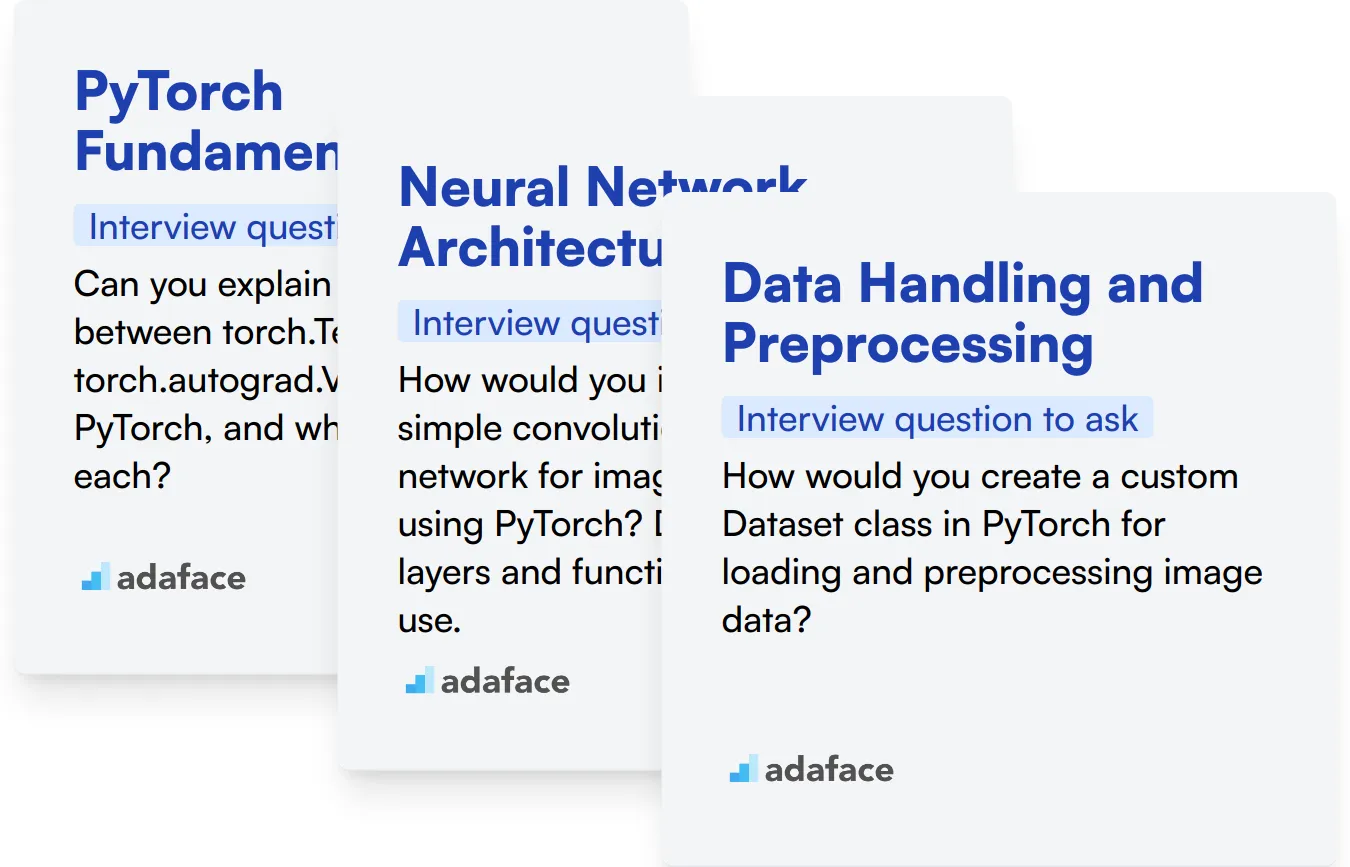
PyTorch Fundamentals
A strong grasp of PyTorch fundamentals is essential for any developer working with this framework. This includes understanding tensors, autograd, and the basic building blocks of neural networks in PyTorch.
To assess this skill efficiently, consider using a PyTorch online test that includes relevant multiple-choice questions. This can help filter candidates based on their foundational knowledge.
During the interview, you can ask targeted questions to gauge the candidate's understanding of PyTorch basics. Here's an example:
Can you explain the difference between torch.Tensor and torch.autograd.Variable in PyTorch, and when you would use each?
Look for answers that demonstrate an understanding of tensors as the basic data structure in PyTorch and the role of autograd in automatic differentiation. A good response should also mention that Variable is now deprecated and tensor objects can require gradients directly.
Neural Network Architecture
Proficiency in designing and implementing neural network architectures is key for PyTorch developers. This skill involves understanding various layer types, activation functions, and how to combine them effectively.
Consider using an assessment that includes questions on neural network design principles and PyTorch-specific implementations. This can help identify candidates with strong architectural knowledge.
To evaluate this skill during the interview, you might ask a question like:
How would you implement a simple convolutional neural network for image classification using PyTorch? Describe the layers and functions you would use.
Look for answers that include the use of nn.Conv2d, nn.ReLU, nn.MaxPool2d, and nn.Linear layers. The candidate should also mention flattening the output before the fully connected layers and using an appropriate loss function and optimizer.
Data Handling and Preprocessing
Effective data handling and preprocessing are crucial for building successful PyTorch models. This skill involves working with PyTorch's data utilities and understanding how to prepare data for model input.
An assessment that includes questions on PyTorch's Dataset and DataLoader classes, as well as common preprocessing techniques, can be valuable in evaluating this skill.
During the interview, you might ask a question like:
How would you create a custom Dataset class in PyTorch for loading and preprocessing image data?
Look for answers that demonstrate understanding of the init, len, and getitem methods. The candidate should also mention techniques for image loading, resizing, and normalization, as well as how to use transforms from torchvision.
3 tips for using PyTorch interview questions
Before you start putting what you’ve learned to use, here are our top three tips for effectively utilizing PyTorch interview questions.
1. Incorporate skills tests before interviews
Using skills tests before conducting interviews can help you filter out candidates who don't meet the technical requirements of the role. This saves you time and ensures that you are interviewing only the most qualified candidates.
Consider using tests from our library such as the PyTorch Online Test, Machine Learning Test, or Deep Learning Test. These tests can assess core competencies and technical skills.
The benefits of using these tests include a streamlined interview process, better candidate quality, and a focus on in-depth interviews. By pre-screening candidates, you can ensure a more effective and focused interview session.
2. Outline and compile relevant interview questions
It's essential to compile a list of relevant and targeted questions to maximize the effectiveness of your interview. You don't have a lot of time, so make every question count.
Consider including related interview questions from different domains like Neural Networks or Machine Learning to get a holistic view of the candidate's skill set.
Additionally, incorporating questions about soft skills such as communication and teamwork can provide a well-rounded assessment of the candidate.
3. Ask follow-up questions
Just using the interview questions isn't enough; it's important to ask follow-up questions to delve deeper into a candidate's knowledge and skills. This helps in understanding the true depth of their expertise and ensures they're not merely repeating rehearsed answers.
For example, if you ask a candidate about their experience with PyTorch's DataLoader, a good follow-up question could be, 'Can you explain a challenging scenario you faced while using DataLoader and how you resolved it?' Such queries can reveal the candidate's problem-solving abilities and practical experience.
Use PyTorch interview questions and skills tests to hire talented engineers
To successfully hire engineers with PyTorch skills, it is important to verify their proficiency through accurate assessment methods. Utilizing skill tests, such as our PyTorch online test, will help you efficiently evaluate their capabilities.
Once you have conducted these assessments, you can easily shortlist the best candidates and invite them for interviews. To streamline your hiring process, consider signing up on our platform at Adaface or explore our test library for more relevant assessments.
PyTorch Test
Download PyTorch interview questions template in multiple formats
PyTorch Interview Questions FAQs
General questions cover topics like PyTorch basics, experience with the framework, and understanding of key concepts.
Ask questions that focus on basic PyTorch concepts, simple coding tasks, and their understanding of neural networks.
Focus on intermediate-level questions including optimization techniques, model evaluation methods, and framework architecture.
Situational questions help gauge a candidate's problem-solving skills and how they apply PyTorch in real-world scenarios.
Cover topics such as types of neural networks, activation functions, loss functions, and backpropagation.
Review PyTorch documentation, practice coding problems, and understand key concepts like the framework's architecture and neural networks.

40 min skill tests.
No trick questions.
Accurate shortlisting.
We make it easy for you to find the best candidates in your pipeline with a 40 min skills test.
Try for freeRelated posts
Free resources




